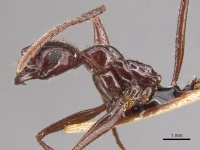Megalomyrmex staudingeri
| Megalomyrmex staudingeri | |
|---|---|

| |
| Scientific classification | |
| Kingdom: | Animalia |
| Phylum: | Arthropoda |
| Class: | Insecta |
| Order: | Hymenoptera |
| Family: | Formicidae |
| Subfamily: | Myrmicinae |
| Tribe: | Solenopsidini |
| Genus: | Megalomyrmex |
| Species group: | leoninus |
| Species: | M. staudingeri |
| Binomial name | |
| Megalomyrmex staudingeri Emery, 1890 | |
| Synonyms | |
| |
Sparse specimen label information suggests this species inhabitats forests found at elevations between 300 - 1000 m.
| At a Glance | • Ergatoid queen |
Identification
Brandão (1990) - Within a series from Santo Antonio do Ica I found a gamergate with 3 ocelli, the flat mesonotum clearly separate from other tergites, petiolar node compressed and the gaster distinctly swollen. The specimen from Iquitos come from bromeliads intercepted at the Miami Airport. Some characters show intraspecific variation. They are: degree of striation around antennal sockets, propodeum shape and the median area of clypeus, wich can be shaped as a flat triangular plate. This condition is extreme at the types of variety described by Forel, but not exclusive.
Distribution
Latitudinal Distribution Pattern
Latitudinal Range: 7.116666667° to -4.1°.
| North Temperate |
North Subtropical |
Tropical | South Subtropical |
South Temperate |
- Source: AntMaps
Distribution based on Regional Taxon Lists
Neotropical Region: Brazil, Colombia, Ecuador, Peru (type locality).
Distribution based on AntMaps
Distribution based on AntWeb specimens
Check data from AntWeb
Countries Occupied
| Number of countries occupied by this species based on AntWiki Regional Taxon Lists. In general, fewer countries occupied indicates a narrower range, while more countries indicates a more widespread species. |

|
Estimated Abundance
| Relative abundance based on number of AntMaps records per species (this species within the purple bar). Fewer records (to the left) indicates a less abundant/encountered species while more records (to the right) indicates more abundant/encountered species. |

|
Biology
Castes
Images from AntWeb

| |
| Holotype of Megalomyrmex staudingeri. Worker. Specimen code casent0904607. Photographer Will Ericson, uploaded by California Academy of Sciences. | Owned by MSNG, Genoa, Italy. |
Nomenclature
The following information is derived from Barry Bolton's Online Catalogue of the Ants of the World.
- staudingeri. Megalomyrmex staudingeri Emery, 1890b: 47 (footnote, diagnosis in key) (w.) PERU.
- Type-material: holotype worker.
- Type-locality: Peru: Iquitos (no collector’s name).
- Type-depository: MSNG.
- Status as species: Dalla Torre, 1893: 71; Wheeler, W.M. 1909b: 237 (in key); Emery, 1922e: 190; Wheeler, W.M. 1925a: 34 (in key); Ettershank, 1966: 105; Kempf, 1972a: 140; Brandão, 1990b: 438 (redescription); Brandão, 1991: 355; Bolton, 1995b: 250; Brandão, 2003: 153; Bezděčková, et al. 2015: 118; Fernández & Serna, 2019: 807.
- Senior synonym of nasutus: Brandão, 1990b: 438; Brandão, 1991: 355; Bolton, 1995b: 250.
- Distribution: Brazil, Colombia, Peru.
- nasutus. Megalomyrmex leoninus r. nasutus Forel, 1912g: 13 (w.) BRAZIL (Amazonas).
- Type-material: syntype workers (number not stated).
- Type-locality: Brazil: Santo Antonio de Iça (Ducke).
- Type-depository: MHNG.
- Status as species: Wheeler, W.M. 1909b: 237 (in key); Wheeler, W.M. 1925a: 34 (in key); Kempf, 1972a: 140.
- Subspecies of leoninus: Emery, 1922e: 190; Borgmeier, 1927c: 100; Ettershank, 1966: 105.
- Junior synonym of staudingeri: Brandão, 1990b: 438; Brandão, 1991: 355; Bolton, 1995b: 249.
Unless otherwise noted the text for the remainder of this section is reported from the publication that includes the original description.
Description
Worker
Brandão (1990) - Mandibles smooth; anterior clypeal border straight with median denticle; 3-segmented antennal club; frontal suture impressed: 24 ocular facets at compound eye largest diameter; occipital margin raised; promesonotal suture generally not impressed dorsally, mesosternum and metasternum without developed acrotergites; dorsal face and declivity of propodeum meeting in a gentle angle, not forming lateral tubercles: dorsal face not transversally impressed; declivity smooth; epipetiolar carina complete; pedunculate petiole with anteroventral denticle originating a translucid longitudinal flange; dorsal margin of petiolar node, in side view, straight; petiolar spiracles laterally produced; dorsal margin of petiolar node, in frontal view, round; ventral face of postpetiole without process; apex of femura acuminate.
Color: deep-brown, almost black.
Type Material
Brandão (1990) - Type Loc.: Iquitos, Loreto, Peru (03°44'S, 73°12'W). Holotype at Museo Civico di Storia Naturale “Giacomo Doria”, Genova. Megalomyrmex leoninus nasutus Forel, 1912: 13. Type Loc.: Santo Antonio do Ica. AM, Brasil (03°05'S, 68°00'W). Nov. syn. (types examined - 2 workers at Museum de la Ville de Geneve).
References
- Adams, R.M.M., Jones, T.H., Jeter, A.W. 2010. Male specific tyramids from three additional myrmicine genera. Biochemical Systematics and Ecology 38 454–456 (doi:10.1016j.bse.2010.03.008).
- Brandão, C. R. F. 1990b. Systematic revision of the Neotropical ant genus Megalomyrmex Forel (Hymenoptera: Formicidae: Myrmicinae), with the description of thirteen new species. Arq. Zool. (São Paulo) 31: 411-481 (page 438, Senior synonym of nasutus)
- Brandão, C. R. F. 2003. Further revisionary studies on the ant gentus Megalomyrmex Forel (Hymenoptera: Formicidae). Pap. Avulsos Zool. (São Paulo) 43: 145-159.
- Emery, C. 1890c. Studii sulle formiche della fauna neotropica. Bull. Soc. Entomol. Ital. 22: 38-80 (page 47, (footnote; diagnosis in key) worker described)
- Liberti, J., Sapountzis, P., Hansen, L.H., Sørensen, S.J., Adams, R.M.M., Boomsma, J.J. 2015. Bacterial symbiont sharing in Megalomyrmex social parasites and their fungus-growing ant hosts. Molecular Ecology 24, 3151–3169 (doi:10.1111/MEC.13216).
References based on Global Ant Biodiversity Informatics
- Ettershank G. 1966. A generic revision of the world Myrmicinae related to Solenopsis and Pheidologeton (Hymenoptera: Formicidae). Aust. J. Zool. 14: 73-171.
- Fernández, F. and S. Sendoya. 2004. Lista de las hormigas neotropicales. Biota Colombiana Volume 5, Number 1.
- Kempf, W.W. 1972. Catalago abreviado das formigas da regiao Neotropical (Hym. Formicidae) Studia Entomologica 15(1-4).

